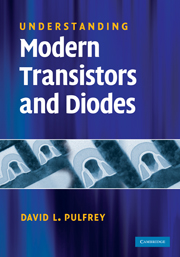Book contents
- Frontmatter
- Contents
- Preface
- 1 Introduction
- 2 Energy band basics
- 3 Electron and hole concentrations
- 4 Thermal equilibrium
- 5 Charge transport
- 6 np- and Np-junction basics
- 7 Solar cells
- 8 Light-emitting diodes
- 9 HBT basics
- 10 MOSFET basics
- 11 HJFET basics
- 12 Transistor capacitances
- 13 Transistors for high-speed logic
- 14 Transistors for high frequencies
- 15 Transistors for memories
- 16 Transistors for high power
- 17 Transistors for low noise
- 18 Transistors for the future
- Appendices
- Index
3 - Electron and hole concentrations
Published online by Cambridge University Press: 05 June 2012
- Frontmatter
- Contents
- Preface
- 1 Introduction
- 2 Energy band basics
- 3 Electron and hole concentrations
- 4 Thermal equilibrium
- 5 Charge transport
- 6 np- and Np-junction basics
- 7 Solar cells
- 8 Light-emitting diodes
- 9 HBT basics
- 10 MOSFET basics
- 11 HJFET basics
- 12 Transistor capacitances
- 13 Transistors for high-speed logic
- 14 Transistors for high frequencies
- 15 Transistors for memories
- 16 Transistors for high power
- 17 Transistors for low noise
- 18 Transistors for the future
- Appendices
- Index
Summary
From the previous chapter we learned that the mobile charge carriers in a semiconductor can be categorized as electrons in the conduction band and holes in the valence band. The carriers occupy states, which define their energy and crystal momentum. One of the objectives of this chapter is to determine the density of these states in energy or momentum, as well as the densities of the carriers in real space. We begin, however, with a look at how the mobile carriers are created and destroyed.
Creation of electrons and holes
The four mechanisms by which electrons (in the conduction band) and holes can be created in the devices discussed in this book can be classed as thermal, optical, electrical, and chemical.
Thermal generation
For temperatures T > 0 K, the lattice atoms vibrate about their mean positions. Occasionally, the local amplitudes of vibration are sufficient to break a valence bond, i.e., to release an electron from the valence band. Obviously, in a perfectly periodic crystal, the energy gained by the electron must be sufficient to promote the electron into the conduction band, as there are no available states elsewhere. The situation is illustrated in Fig. 3.1, where an electron from state 〈1〉 in the valence band is promoted to state 〈1′〉 by the absorption of phonons.
- Type
- Chapter
- Information
- Understanding Modern Transistors and Diodes , pp. 30 - 48Publisher: Cambridge University PressPrint publication year: 2010



